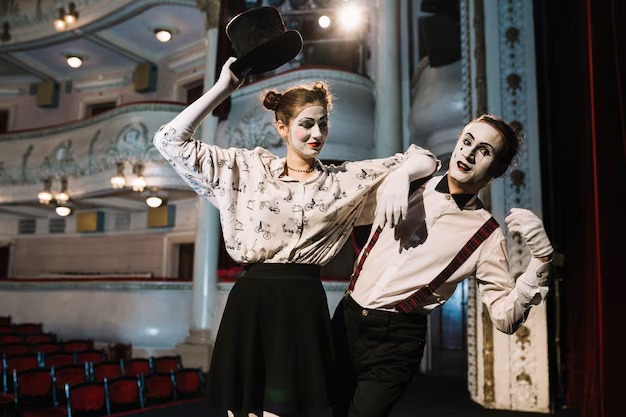
23 December 2024
Exploring Dystopian Operas A Beginner Guide to the Red Rising

In the realm of imaginative storytelling, there lies a vibrant narrative that captivates audiences with its grand themes and larger-than-life characters. This artistic creation weaves together folklore and enchanting melodies, inviting listeners on an extraordinary journey filled with adventure, camaraderie, and heroism. With a rich tapestry of sounds and sights, this performance transcends mere entertainment, offering a glimpse into a world where myths come alive.
From towering figures who shape the landscape to whimsical creatures that dance through the narratives, this captivating rendition illustrates profound connections between nature and humanity. Audiences are transported to a time where legends are crafted and dreams take flight, emphasizing timeless values of friendship and resilience. Every note played and every verse sung elevates the experience, immersing those present in a celebration of both artistry and culture.
By exploring this vibrant narrative, participants gain not only an appreciation for musical craftsmanship but also an understanding of how tales resonate through generations. As viewers engage with this rich artistic experience, they find themselves enchanted by the resonant themes that echo within their own lives, creating a bridge between past and present. Embracing the spirit of adventure, this remarkable performance promises to linger in memories long after the final curtain falls.
Unraveling the beginnings of this legendary figure reveals a tapestry woven from folk tales, cultural anecdotes, and regional pride. The character represents the spirit of resilience and grandeur, embodying a world where larger-than-life personas thrive. Various interpretations have emerged over time, contributing to the rich narrative surrounding his existence.
Folksong collections and oral histories play a crucial role in preserving the essence of this monumental character. Understanding how he has evolved throughout history allows one to appreciate the depth and vibrancy of modern interpretations.
Folklore serves as a vital expression of cultural identity, intricately woven into the fabric of a society’s heritage. It embodies collective experiences, shared values, and imaginative narratives that transcend generations. Through folk tales, songs, and traditions, communities strengthen their bonds, passing down wisdom and moral lessons in an engaging manner.
These narratives not only entertain but also provide insight into historical contexts and societal norms, shaping individuals’ understanding of their environment. The representation of larger-than-life characters and fantastical elements reflects human aspirations, fears, and the pursuit of meaning, enriching cultural landscapes.
| Element | Significance |
|---|---|
| Folklore | Preserves cultural heritage and identity |
| Characters | Embodiments of human traits and aspirations |
| Narratives | Convey moral lessons and social values |
| Traditions | Strengthen community bonds and shared identities |
This art form captivates audiences with its distinct elements that intertwine folklore, music, and theatrical performance. It presents a unique blend of cultural traditions and innovative storytelling techniques, making it a memorable experience for all who attend.
These elements combined create a riveting experience that resonates with both the heart and mind, ensuring an unforgettable journey into a world of adventure and imagination.
This segment delves into distinctive characteristics that shape the auditory experience of this notable theatrical work. The score, instrumentation, and vocal techniques come together to create an immersive atmosphere that captivates the audience.
The performance style showcases a combination of theatricality and artistry, engaging viewers through dynamic interpretations and expressive movements. Key aspects of this approach include:
In summary, this synthesis of musical attributes and performance methods creates a vibrant and memorable experience that resonates long after the final curtain falls.
The narratives surrounding this iconic figure have profoundly influenced contemporary society, shaping artistic expressions and community identities. By intertwining folklore with modern aesthetics, these tales continue to inspire various creative outlets.
Ultimately, these enduring tales demonstrate how age-old narratives can resonate within contemporary contexts, fostering connections between past, present, and future generations.
Captivating spectators is an art that transcends mere performance; it lies in the ability to weave narratives that resonate deeply. By crafting compelling tales, performers can create connections that transcend language and culture, drawing listeners into a vivid world where emotions soar.
Storytelling serves as a bridge, allowing individuals to experience various perspectives and feel a range of emotions. It invites audiences on a journey, encouraging them to invest their thoughts and feelings into the unfolding narrative. Every character becomes a vessel through which spectators explore their dreams, fears, and aspirations.
Moreover, the profound impact of a well-told tale can linger long after the final curtain. Through artistic expression, the themes and messages conveyed through storytelling can inspire action, provoke thought, and evoke lasting memories, fostering a sense of community among those who share in the experience.
Auden’s contribution to modern opera is significant because he brought a unique poetic sensibility to the genre, influencing the way librettos are crafted and how narratives are expressed in opera.
The operetta differs from traditional opera in that it typically features lighter themes, spoken dialogue, and a more accessible musical style, often incorporating elements of comedy and romance.
The libretto serves as the text or script of an opera, providing the storyline, character development, and lyrics for the musical numbers, making it essential for conveying the opera’s themes and emotions.
Auden collaborated with Benjamin Britten on the operetta “Paul Bunyan,” which showcases their innovative approach to storytelling through music and verse.
Auden’s poetic style influences the libretto of his operas by introducing rich imagery, intricate wordplay, and emotional depth, enhancing the overall experience of the performance.
Common themes found in Auden’s operettas include love, social commentary, and the exploration of human relationships, often presented with a blend of humor and poignancy.
The music in an operetta often features lighter melodies and simpler harmonies compared to standard opera, focusing on entertainment value and accessibility for a broader audience.
The relationship between the libretto and the musical score in an opera is symbiotic, as the libretto provides the narrative framework while the musical score enhances emotional expression and dramatic impact.
One famous operetta that has become a staple in contemporary performances is “The Merry Widow” by Franz Lehár, known for its memorable melodies and engaging storyline.
Auden’s background as a poet and his interest in social issues influenced his work in opera and operetta, allowing him to integrate literary depth and critical perspectives into the librettos he created.
The Royal Opera House is significant in Richard Hickox’s career as it served as a prominent venue where he conducted various operatic performances, showcasing his talent and helping to establish his reputation in the classical music community.
Covent Garden played a crucial role in the success of Benjamin Britten’s operas by providing a prestigious platform for their premieres, including works like “Peter Grimes,” which received critical acclaim and helped solidify Britten’s status as a leading composer.
The “Inkslinger” character in Britten and Auden’s collaboration explores themes of regret and longing, particularly highlighted in the ballad “Inkslinger’s Regret,” which reflects on the complexities of life and choices made.
Pamela Helen Stephen performed the role of Helson in the Plymouth Music Series production of “Paul Bunyan,” bringing depth to the character and contributing to the overall narrative of the opera.
“Carrie’s Death” is significant in the storyline of “Paul Bunyan” as it marks a pivotal moment that affects the characters’ dynamics and highlights themes of loss and resilience within the context of the lumberjack camp.
The third ballad interlude in “Paul Bunyan” contributes to the overall structure by providing a reflective pause in the narrative, allowing characters to express their emotions and thoughts, which enhances the operatic experience.
Peter Coleman-Wright plays a key role in the operatic adaptation of “Paul Bunyan,” lending his voice to bring characters to life and adding to the richness of the musical score composed by Benjamin Britten.
“The Birth and Early Life of Paul Bunyan” sets the stage for the opera’s narrative by introducing key elements of folklore, establishing Paul’s legendary stature, and foreshadowing his adventures alongside characters like Babe the Blue Ox.
W.H. Auden had a significant impact on modern operatic storytelling through his work with Britten by infusing poetic language and social commentary into librettos, allowing for deeper emotional connections and thematic exploration within operas.
“Make Way for Civilisation” reflects societal changes in “Paul Bunyan” by addressing the tension between nature and progress, illustrating how the lumber industry impacts both the environment and the lives of those living in it.
Leave a comment